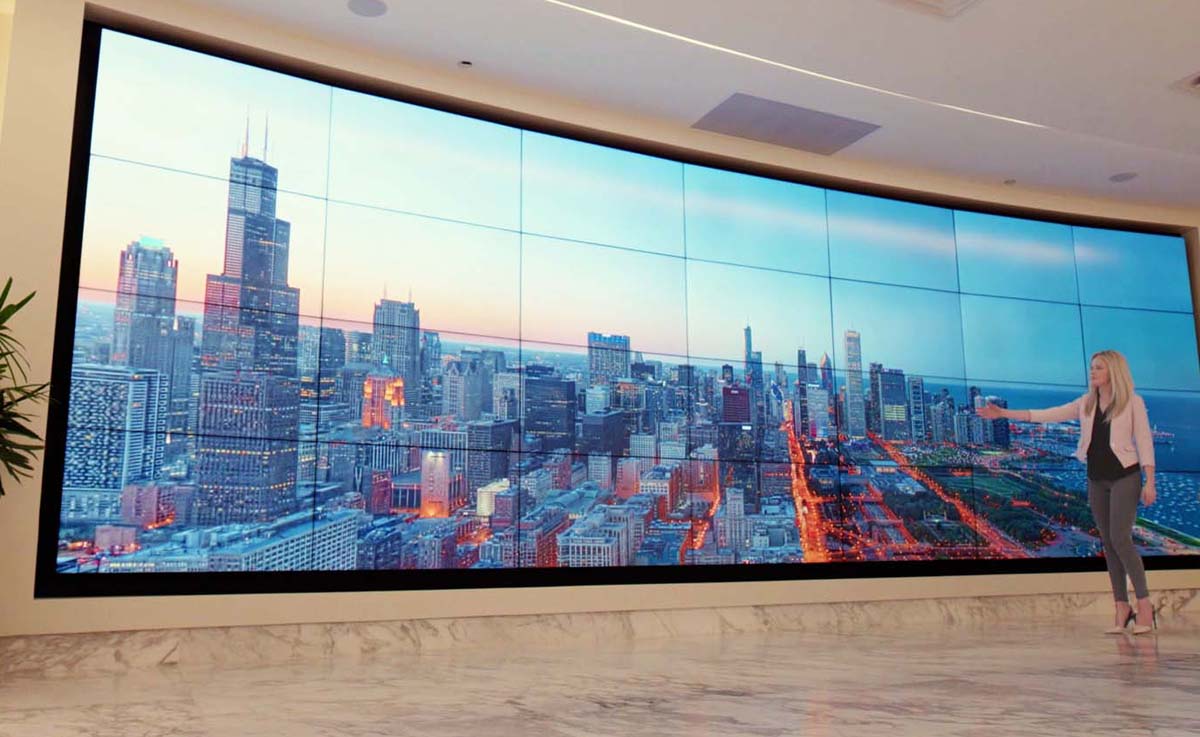Modern retail, museum, hospitality and other commercial interiors have a problem: How to captivate in-person audiences that already have a powerful, customized, and addictive form of entertainment in their back pockets nearly 24/7?
Traditional static displays and printed materials are no longer enough to capture the attention of distracted but discerning consumers. Enter LED video walls – these dynamic, immersive brand experiences are elevating commercial interiors across industries. Imagine walking into a retail space and being mesmerized by a seamless, floor-to-ceiling digital canvas that brings products to life with vivid colors and captivating motion. Or, picture a corporate interior that welcomes visitors with a breathtaking array of high-resolution visuals that bring the company’s history to life. LED video walls are changing the way innovative brands engage with their audiences.
In this comprehensive guide, we'll explore the world of LED video walls for immersive experiences, from their technical specifications and design considerations to their unparalleled ability to captivate audiences and drive tangible business results. Whether you're a brand manager, CEO, or CMO, this article will provide you with the knowledge and insights you need to harness the power of this media-driven technology and stay ahead of the curve in an increasingly competitive marketplace.

What is an LED Video Wall?
An LED video wall is a large-scale display system composed of multiple LED panels or tiles that work together to create a seamless video canvas. Unlike traditional screens or projections, LED video walls offer superior image quality, brightness, and viewing angles, making them ideal for displaying dynamic content in commercial environments.
While LED panel walls are often seen in sports arenas (hello, Jumbotrons!) and airports, top brands are now using them in sophisticated corporate lobbies and sales centers, retail environments, universities, and hospitality venues to create an immersive, engaging experience for visitors.
How are LED Video Walls Used in Commercial Environments?
Beyond merely displaying vivid visuals, LED video walls are utilized to highlight product features and benefits in an immersive manner that static displays cannot. For instance, in retail settings, LED walls can provide in-depth information about how a product is made, or demonstrate, in vivid detail, its features and benefits. This educates and informs but also creates an engaging digital storytelling experience that resonates with consumers on a deeper level.
The versatility of LED video walls extends to conveying brand values and history in corporate environments. By integrating high-resolution imagery, video content, and interactive elements, companies can craft immersive narratives that communicate their ethos, milestones, and future aspirations. This approach educates and builds an emotional connection with visitors, setting the stage for lasting impressions. Furthermore, through interactive games and wayfinding features, businesses can transform passive waiting areas into engaging spaces that entertain while subtly reinforcing brand messaging. The unparalleled brightness and clarity of LED video walls capture attention in bustling settings, making them a powerful tool for high-impact visuals and messages that cut through the noise.
LED video walls are not just about stunning visuals; they are a conduit for interactive storytelling, education, and engagement. Their application across industries underscores the shift towards experiential marketing—where creating an immersive brand experience becomes a critical driver of consumer interest and loyalty. By harnessing this technology, businesses can elevate their interior spaces, offering experiences that are not only captivating but also enriching and memorable.

A custom LED video wall welcomes visitors and employees at a commercial office in San Diego.
What Technical Specifications are Required for an LED Video Wall?
A strategic combination of technology and planning is essential to leverage the capabilities of LED video walls. At the core of this system are LED panels, which are the building blocks of the video wall. These panels come in various resolutions, brightness levels, and sizes, allowing for customization to fit the space. Equally critical is a sophisticated Show Control System, which operates as the brain of the setup. This system manages the content displayed on the video walls, enabling real-time updates, interactive features, and synchronization across multiple panels. The choice of technology hinges not only on the desired visual impact but also on the ability to deliver seamless, dynamic content that engages and captivates the target audience.
Several key factors come into play when determining the specific requirements for an LED video wall installation. The intended objective—whether it's brand storytelling, product showcasing, or interactive engagement—guides the selection of technology, particularly in terms of resolution and interactivity. The installation environment dictates the necessary brightness levels and panel durability, with outdoor settings demanding higher brightness and weather-resistant panels. The proximity of the intended audience influences the pixel pitch, as closer viewer distances require finer resolutions for image clarity. Lastly, the ambient lighting conditions of the installation area determine the need for panels with higher luminosity to ensure visibility and impact. These considerations ensure that each LED video wall installation is technologically advanced and perfectly tailored to its intended purpose and environment, maximizing its effectiveness.
What are Some Alternatives to LED Video Walls?
Projection-Mapping
Projection mapping and LED video walls deliver visual content in fundamentally different ways, catering to unique experiences and applications. Unlike LED video walls, which consist of a series of panels emitting light to create images, projection mapping utilizes projectors to cast video or images onto any surface, regardless of shape, size, or texture. This flexibility allows for surreal and dynamic visual storytelling that can transform ordinary structures into extraordinary canvases. Projection mapping excels in environments where physical architecture is central to the narrative, such as historical buildings, museums, and live events. It's particularly effective for temporary installations or events where the immersive quality of the visual experience is paramount, allowing for a dramatic interplay of light and structure without the need for physical screens. It is less effective for outdoor daytime applications or in situations with a lot of ambient lighting. Projectors are also more sensitive to weather and dust.
Tiled Monitors
Where LED panels offer seamless integration to form a continuous visual surface, monitor tiles—akin to traditional television screens—struggle to achieve a fully seamless visual experience due to the presence of bezels that can disrupt the continuity of the displayed content. Monitor tiles also often underperform in brightly lit environments compared to LED panels, which boast superior brightness and contrast. This inherent limitation impacts their efficacy in areas with abundant ambient light, making them less suitable for outdoor applications or brightly lit indoor spaces. Their overall visual quality tends to be lower than that of LED panels, which deliver higher resolutions and more vibrant color representations, resulting in a less-optimal viewer experience.
How Much Does an LED Video Wall Cost?
The overall cost of an LED video wall can significantly vary, largely influenced by two critical factors: the size of the wall and the required quality of resolution. Size is straightforward—larger installations necessitate more panels, thereby increasing the cost. However, understanding resolution requirements is a bit more complex.
When the audience is closer to the wall, a higher resolution is imperative to maintain image clarity and detail, elevating the expense. This is because higher-resolution panels typically employ more LEDs per square inch, a factor that directly contributes to higher costs. The balance between audience proximity and resolution quality underscores the need for careful planning and consideration in the initial stages of designing an LED video wall system, ensuring the chosen specifications align with the intended visual experience and audience engagement objectives.
While off-the-shelf options are available, tailored systems, designed in collaboration with an experiential technology partner, ensure that every component—from panels to content management systems—is meticulously selected to meet the specific requirements of the display environment and content type. This customization ultimately delivers superior results by optimizing the video wall’s effectiveness in engaging audiences and achieving communicative goals. A custom-designed LED video wall transcends mere visual appeal, it's a strategic tool for captivating and communicating with target audiences in the most impactful way.

A giant curved LED video wall engages and educates visitors at the UM Alumni Center.
What are the Benefits of LED Video Walls for Brand Experiences?
Technical Benefits of LED Video Walls
- Delivery of true blacks and seamless images.
- Capability to create displays in non-traditional shapes and dimensions for innovative and immersive displays.
- No bulbs are required, reducing concerns about dust and environmental factors.
- Crisp, bright images in all types of lighting situations.
- Long lifespan of LEDs, offering sustainable and cost-effective display solutions
- Suitable for tight spaces or outdoor settings, thanks to their versatile display capabilities.
- Ability to project seamless images of any size or shape, including non-traditional formats like circles.
Marketing Advantages of LED Video Walls
- Entices people into spaces with appealing visual elements.
- Creates a unique brand experience, leaving a lasting impression on viewers.
- Differentiates brand from competitors, showcasing modernity and technological savviness.
- Captivates audiences with vibrant and dynamic displays that can be changed and updated.
- Boosts employee morale by fostering a stimulating work environment.
- Elevates brand perception and bolsters brand affinity.
- Educates and informs consumers about products, brand values, and history.
Final Thoughts on LED Video Walls
From retail environments and corporate lobbies to event venues and public spaces, these dynamic displays can mesmerize viewers, convey brand narratives, and drive tangible business results – solving the problem of how to captivate in-person audiences and leave a lasting impression.
The long-term benefits of increased engagement, brand differentiation, and potential revenue generation make LED video walls a worthwhile consideration for forward-thinking organizations. By carefully evaluating your specific needs, budgets, and desired outcomes, you can harness the power of this technology to create immersive, memorable experiences that resonate with your audiences and propel your businesses forward in an increasingly competitive landscape.
At Bridgewater Studio, we offer a comprehensive approach to LED video walls and all media and technology integrations by weaving strategy, design, and production into the conversation from the very beginning. As an end-to-end experiential production studio, we help clients define their goals and objectives, articulate their message, and maximize their budgets by using the best means and methods every step of the way. Ready to elevate your commercial interior with an interactive media experience? Book a no-obligation strategy session with Bridgewater today.


.png)
.png)
.png)







